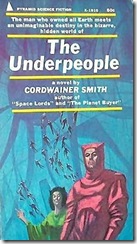 The Underpeople is actually the second half of a much longer novel called Norstrilia that editors broke up into two shorter novels. In the 1960s a paperback was about 160 pages plus or minus 10. Font size and line spacing was tweaked to arrive at this number, or failing that, they chopped the book up. As a result, I am reading the second half of a great novel without any idea of what came before. I imagine I’ll find the first half in the same box where I found this.
The Underpeople is actually the second half of a much longer novel called Norstrilia that editors broke up into two shorter novels. In the 1960s a paperback was about 160 pages plus or minus 10. Font size and line spacing was tweaked to arrive at this number, or failing that, they chopped the book up. As a result, I am reading the second half of a great novel without any idea of what came before. I imagine I’ll find the first half in the same box where I found this.
My first contact with Cordwainer Smith was in the pages of old pulp magazines. I only knew that he wrote wrenchingly intense poetic short stories and that you could only find him in magazines. This was because he didn’t write that much and died at the age of 53. The Underpeople was published after his death by his wife. His real name was Paul Myron Anthony Linebarger. He worked for the army during WWII and wrote a book called Psychological Warfare, which is considered a standard text on the subject. I am trying to find it, but the cheapest copy around is $200.
Smith doesn’t write fiction as we know it. I like to think of it as hallucinogenic poetry, but that doesn’t really describe it either. Smith was raised in China and his God-father was Sun Yat-Sen and and later was a close friend of Chiang Kai-sheck. He spoke 6 languages fluently and his stories have been compared in structure to the Chinese stories, which is why they sound so strange when you read them.
If you read Samuel R. Delaney, J.G. Ballard or R.A. Lafferty, you can see what I mean by hallucinogenic poetry. His stories are more metaphysical metaphors than linear narratives. The constant use of metaphor reminds one of Jurgen by James Branch Cabell. The stories are sharp, crystal clear, and intensely poetic. This works well with his stories.
I find that the flashing cuts of image works less well as a novel. Don’t get me wrong, I appreciate this book. I am reading it slowly and sometimes rereading a paragraph several times to savor the language, but the plot and characters are not very real to me. It is like a prismatic dream that jumps from element to element before the glow can die down. It is intricate and surreal, but it is not necessarily good story telling. I don’t think that you could read Smith the same way you would read a thriller or a mystery. You would not be engrossed in the events or characters, just the emotional impact of beautiful imagery.
I am hoping that there is more Cordwainer Smith in the box. It doesn’t really matter if I read the two halves of this novel out of order. I am reading it for the exquisite element of Cordwainer-ness in the book.
2 Comments
I’ve read Norstrilia in its entirety so many times that I can’t quite imagine what it would be like to read it as you are doing. Come by my website, cordwainer-smith.com, for lots more about this evocative writer. BTW, on the page of other internet resources, there are links to several of his short stories that you can read online.
Rosana Linebarger Hart, CS’ daughter
Rosana,
Thank you for dropping by. I finished it on the way home today and the emotional impact hit me hard. He was a great writer. This is one of those books that demands to be read over again, soon.
I recently bought a couple of hundred classic sf paperbacks on eBay and I am writing a little bit about each one as I read it. I will have to start digging in the piles of books to find more CS.